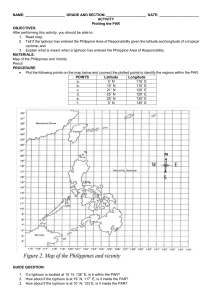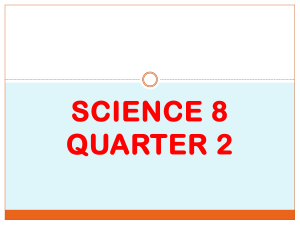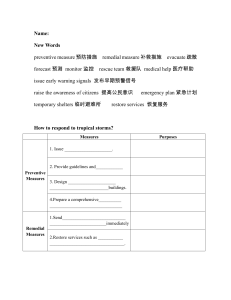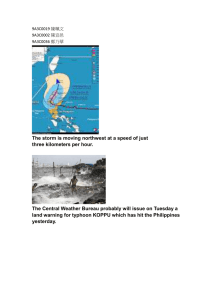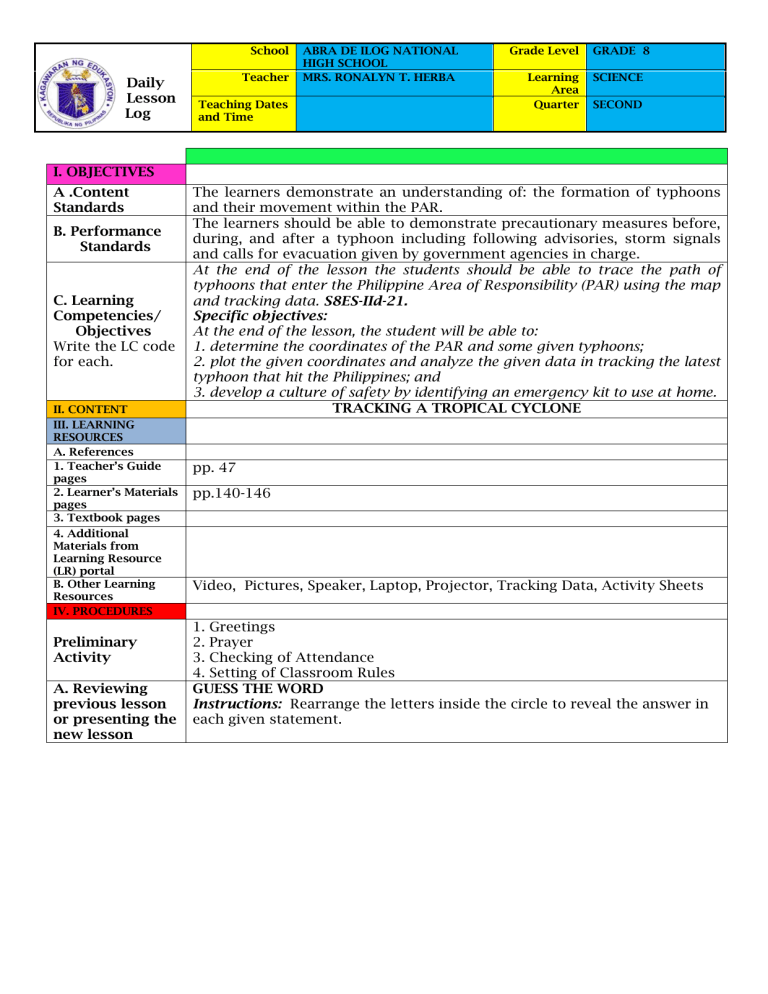
School Daily Lesson Log Teacher Teaching Dates and Time ABRA DE ILOG NATIONAL HIGH SCHOOL MRS. RONALYN T. HERBA Grade Level Learning Area Quarter GRADE 8 SCIENCE SECOND I. OBJECTIVES A .Content Standards B. Performance Standards C. Learning Competencies/ Objectives Write the LC code for each. II. CONTENT III. LEARNING RESOURCES A. References 1. Teacher’s Guide pages 2. Learner’s Materials pages 3. Textbook pages 4. Additional Materials from Learning Resource (LR) portal B. Other Learning Resources IV. PROCEDURES Preliminary Activity A. Reviewing previous lesson or presenting the new lesson The learners demonstrate an understanding of: the formation of typhoons and their movement within the PAR. The learners should be able to demonstrate precautionary measures before, during, and after a typhoon including following advisories, storm signals and calls for evacuation given by government agencies in charge. At the end of the lesson the students should be able to trace the path of typhoons that enter the Philippine Area of Responsibility (PAR) using the map and tracking data. S8ES-IId-21. Specific objectives: At the end of the lesson, the student will be able to: 1. determine the coordinates of the PAR and some given typhoons; 2. plot the given coordinates and analyze the given data in tracking the latest typhoon that hit the Philippines; and 3. develop a culture of safety by identifying an emergency kit to use at home. TRACKING A TROPICAL CYCLONE pp. 47 pp.140-146 Video, Pictures, Speaker, Laptop, Projector, Tracking Data, Activity Sheets 1. Greetings 2. Prayer 3. Checking of Attendance 4. Setting of Classroom Rules GUESS THE WORD Instructions: Rearrange the letters inside the circle to reveal the answer in each given statement. Guide Questions: 1. In our country, the Philippines, what is the term we use to pertain a typhoon? “Bagyo” 2. Have you heard about the superstitious belief that was believed by our grandparents to know that there is an incoming typhoon? “Yes, whenever the birds are in a rush to fly away from one place or another, or if when the ants are trying to build their colony inside your house.” Indicator #7 Established a learner-centered culture by using teaching strategies that respond to their linguistic, cultural, socio-economic and religious backgrounds. Linguistic= the use of the word “Bagyo” Cultural=the superstitious belief that if the if birds are flying low or seeking shelter, it may be seen as a sign of an impending storm. Indicator #8 Adapted and used culturally appropriate teaching strategies to address the needs of learners from indigenous groups. PLOTTING THE PAR B. Establishing a purpose for the lesson Objectives: After performing this activity, you should be able to: 1. read map; 2. given the latitude and longitude of a tropical cyclone, tell if it has entered the Philippine Area of Responsibility; and 3. explain what is meant when a typhoon has entered the Philippine Area of Responsibility. Materials Needed: map of the Philippines and vicinity pencil Procedure: 1. Plot the following points on the map below (Figure 1). 2. Connect the plotted points. The region within is the Philippine Area of Responsibility or PAR. It is the job of PAGASA to monitor all tropical cyclones that enter this area. Questions: 1. If a typhoon is located at 15°N, 138°E, is it within the PAR? 2. How about if the typhoon is at 19°N, 117°E, is it inside the PAR? Indicator #2 Used a range of teaching strategies that enhance a learner achievement in literacy and numeracy skills. MELC: Trace the path of typhoons that enter the Philippine Area of Responsibility (PAR) using the map and tracking data. ( S8ES-IId-21) C. Presenting examples / instances of the new lesson Let the student watch a videoclips about a typhoon that is entering in PAR (Philippine Area of Responsibility). Discuss how to track a tropical cyclone using latitude and longitude. Present to the class how to locate it. Using the Map of the Philippines and vicinity, plot the given points on the Map. D. Discussing new concepts and practicing new skills #1 Latitude 5°N 15°N 21°N 25°N 25°N 5°N 1. 2. 3. 4. If the If the If the If the typhoon typhoon typhoon typhoon Longitude 115°E 115°E 120°E 120°E 135°E 135°E is located at 17°N, 138°E, is it within PAR? is at 19°N, 115°E, is it within PAR? is at 18°N, 125°E location, is it within PAR? is located at 8°N, 130°E, is it within PAR? Indicator #1 Applied knowledge of content within and across curriculum teaching areas. Indicator #2 Used a range of teaching strategies that enhance a learner achievement in literacy and numeracy skills. E. Discussing new concepts and practicing new skills #2 The student will be grouped heterogeneously based on their home location. Each group will track a tropical cyclone using the given coordinates (latitude, longitude). Group I - Typhoon Jenny Group 2 - Typhoon Falcon Group 3 – Typhoon Onyok Group 4 – Typhoon Egay Indicator #7 Established a learner-centered culture by using teaching strategies that respond to their linguistic, cultural, socio-economic and religious backgrounds. Indicator #8 Adapted and used culturally appropriate teaching strategies to address the needs of learners from indigenous groups. Grouping the students heterogeneously gives a chance for the students to share their unique experiences on the proper way and beliefs about typhoon, according to the location of their home. Indicator #9 Used strategies for providing timely, accurate and constructive feedback to improve learner performance. Instructions: Analyze the track of tropical cyclone Haiyan and then answer the guide questions. F. Developing Mastery (Leads to Formative Assessment) Questions: __ 1. What is the Philippine name of the weather disturbance? __ 2. When did Yolanda enter the PAR? __ 3. When did Yolanda made its first landfall? __ 4. When did Yolanda leave the PAR? __ 5. Where did Yolanda made its first landfall? G. Finding practical application of concepts and skills in daily living Calamities like typhoons may happen at any time. If we do not prepare for it, our life might be more at risk. It is always wise to think ahead and be prepared for the worst. Instructions: Below is an Emergency Bag (E-Bag). From the choices in the box, list down 9 most important items that you will be putting inside your E-Bag. The answers may be in any order. Write the letters only. Fill in the blanks with the correct term to complete the statements. Write your answers on a separate sheet of paper. H. Making generalizations and abstractions about the lesson I. Evaluating learning 1. Tracking the movement of a _________ the moment it is formed, is very essential because if the track forecast is incorrect, wind speed, rainfall and storm surge threats will also be incorrect. 2. Ocean waters must reach a minimum temperature of _________ in order for a tropical cyclone to develop. 3. A large-scale wind moving in a particular direction over the ocean pushes the tropical cyclones to move in _________ direction. 4. When tropical cyclones reach land, they _________ because they are cut off from the water supply. 5. In the eye of a tropical cyclone, wind speed is _________. Using the map track of tropical storm, determine the latitude and longitude of the storm LAWIN (International name: HAIMA) in the table given the month/day/time. Month/Day/Time 1. 8PM, J. Additional activities for application or remediation V. REMARKS VI. REFLECTION A. No. of learners who earned 80% on this formative assessment B. No. of learners who require additional activities for remediation C. Did the remedial lessons work? No. of learners who have caught up the lesson D. No. of learners who continue to require remediation E. Which of my teaching strategies worked well? Why did these work? F. What difficulties did I encounter which my principal or supervisor help me solve? G. What innovation or localized latitude longitude 17 OCT.2016 2. 8PM, 18 OCT.2016 3. 8PM, 19 OCT.2016 4. 8PM, 20 OCT.2016 5. 8PM, 21 OCT.2016 Bring a weather data report (air pressure and wind speed) taken from the newspaper. materials did I used/discover which I wish to share with other teacher?
